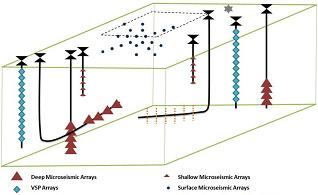USC Induced Seismicity Consortium and Reservoir Monitoring Consortium releases a report on new results for “Optimized passive seismic survey design with simultaneous borehole and surface measurements”. The members of ISC and RMC can access the full report.
This project attempts to develop a new integrated framework for optimized multi array passive seismic monitoring programs based on specific requirements set forth at the initiation of the project. We have defined a new framework based on existing microseismic array optimization workflows and deployed this framework into a working implementation within Matlab environment for potential use. While the algorithm as tested shows a lot of promise for actual deployments in the field, tests with real data can provide the necessary confidence to use it for future programs. This project has been funded by a GTI grant and is aimed at understanding the elements which influence the design of multi array passive seismic monitoring programs and to develop a framework for optimization of such arrays for improved Hypocentral locations and source mechanisms while optimizing deployment costs. This report provides an extensive background on the optimization framework used in tour work as well as results with necessary observations and recommendations for future multi array receiver deployments. (Refer Appendix A for the original proposal and work plan)
The work was supported in part by a grant from Gas Technology Institute (GTI) through RPSEA funding. It was also supported by ISC and RMC.


